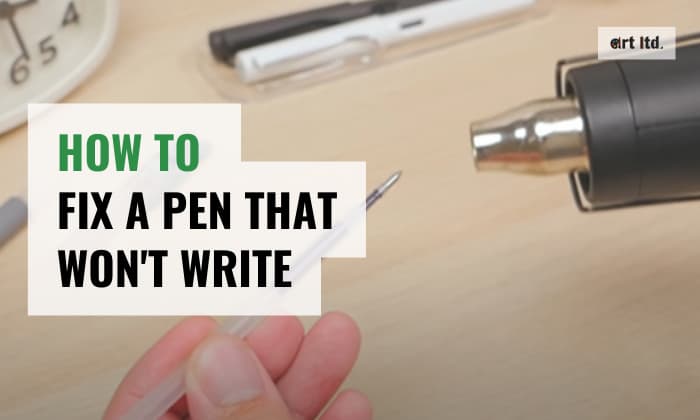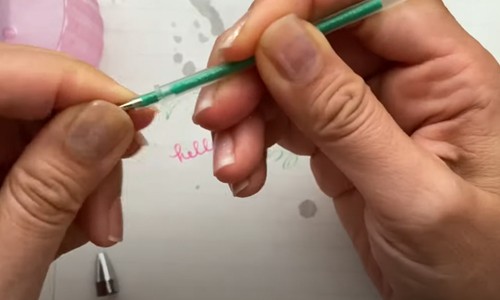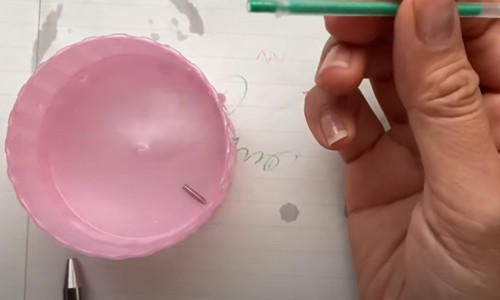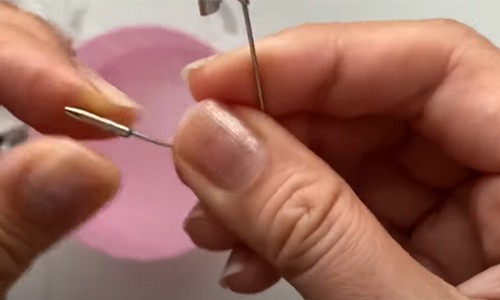A pen is a simple and essential writing tool we often take for granted. However, it can be frustrating when a pen has ink but won’t write, especially when we need it the most. Fortunately, there are several methods that can help fix the problem.
By understanding the common causes of a malfunctioning pen and following the right steps, you can quickly get your tool back to working again. Dive in to learn how to fix a pen that won’t write.
Table of Contents
Ways to Fix a Pen That Won’t Write
1. Manual Strategies

Sometimes, the pen’s ballpoint can become clogged or stuck, making the pen ink not flowing.
- To fix this issue, try scribbling on a rough surface, such as a piece of sandpaper or the sole of your shoe. It can help dislodge any blockages and get the ink flowing again.
- Be careful not to apply too much pressure or damage the pen tip.
- After scribbling on the rough surface, try writing on paper to see if the pen is working properly.
2. Shake The Pen
If the pen has been sitting for a while, the ink can settle at the bottom of the cartridge and lead to the tool not writing well.
- You can shake the pen vigorously for a few seconds. This can help distribute the ink evenly and get it flowing again.
- Remember to hold the pen in one hand with the tip pointing down.
- However, you should avoid doing this with a fountain pen because it can cause the ink to splatter.
3. Blow Into A Pen
Blowing into the pen can help dislodge any dried ink or debris blocking the ballpoint and make a pen write again. To do this:
- Remove the pen cap and hold the pen end near your mouth. Blow gently into the pen, ensuring not to inhale any ink or debris that may be released.
- However, blowing into a pen can also cause the ink to be forced further up into the pen’s ink reservoir or even cause the ink to leak out. So control the blowing force.
4. Replace The Refill
Replacing the refill of a pen is a common and effective way to fix a pen that won’t work. Refills come in various sizes, shapes, and colors, so it’s important to ensure you purchase the correct one for your pen.
To replace the refill, follow these steps:
- Step 1: Remove the pen cap and unscrew the pen barrel to reveal the old refill.
- Step 2: Gently pull the old refill out of the pen. You can gently wiggle it back and forth until it comes loose. If the pen is connected with a spring, remove it.
- Step 3: Insert the new refill into the pen and screw the barrel back on. Make sure the refill is the correct size and fits securely into the barrel.
Note: If your pen doesn’t retract as normal, you can fix a pen that won’t click by checking the contact between the refill and the plunger or reversing the spring and removing any dirt inside the pen.
5. Tool Strategies
1. Use Heat
- Step 1: Take the refill out of the ballpoint pen.
- Step 2: Using a blow dryer, heat the pen tip for 10 seconds.
A lighter or match can be an alternative, but hold the pen at a safe distance from the flame and do not overheat the tip.
- Step 3: If the pen still doesn’t work, soak it in 1 cup of hot water for 10-15 minutes.
You can put the refill in a ziplock bag to prevent the ink from mixing with water and staining the cup.
- Step 4: After heating the tip, let the pen cool for a few seconds, then write with it.
This will prevent you from burning yourself and allow the ink to flow through the ballpoint.
You may need to repeat the process if the pen is still not writing after several attempts.
2. Use Safety Pin
- Step 1: Remove the pen case from the gel pen and take out the ink refill.
- Step 2: Remove the small metal tip at the end of the ink refill. This part of the refill comes into contact with the paper and can sometimes become clogged.
- Step 3: Fill a small cup or container with water and submerge the tip of the ink refill into the water for a few minutes. It will help to soften any dried ink that may be clogging the pen.
- Step 4: Take the tip out of the water, then use a safety pin and plug it through the pen nib. Be careful not to injure yourself.
Move the safety pin around gently to dislodge any dried ink or debris blocking the nib. You can also gently twist the safety pin to help break up any blockage and get a pen to write again.
- Step 5: When the blockage has been removed, use a paper towel or tissue to dry the tip.
- Step 6: Reinsert the ink refill into the pen and test it to see if it is flowing properly.
3. Use rubbing alcohol or acetone
The steps for this method are simple.
- Pour some rubbing alcohol or acetone into a small bowl and dip the pen tip in it.
- Avoid submerging other parts of the pen in the solvent, especially those made of plastic, then try writing to see if ink flows out smoothly.
Why Won’t a Pen Write?
One common reason is that the ink inside the pen has dried out or become clogged. This can happen when the pen is left unused for an extended period.
A pen full of ink won’t write if the ballpoint or rollerball at the pen’s tip is damaged or worn out.
In addition, a new pen won’t write if it has grip or internal mechanisms issues after being stored uncapped or with the tip up for too long.
How to Prevent It?
- Store your gel pens upright with the tip facing down and keep the pen in the “closed” position.
This way, the ink is always in contact with the pen’s tip, ensuring that the pigment flows smoothly and continuously when you use the pen.
- Keeping pens in airtight bags can also prevent them from drying out.
It will minimize the amount of air that comes into contact with the pens, slowing the evaporation process and keeping the ink from drying.
Tips for Maintaining Pen Performance
- Always keep the pen clean.
- Replace the pen nib and refill as needed.
- Keep your pen in a dry and cool location.
- Handle the pen properly and avoid dropping or applying too much pressure when writing to prevent damage to the nib or other parts.
Conclusion
How to fix a pen that won’t write? You can scribble, shake, or blow into it. Also, check the refill and replace it if needed.
Alternatively, you can use a lighter, a blow dryer, a safety pin, or dip the pen into warm water to make ink come out of a pen.
Identifying the issue, such as a clogged nib or dried-out ink, and taking appropriate measures to address it can restore most pens to working order.
With some patience and basic troubleshooting, you can keep your favorite pen writing smoothly for years to come.

Art has always been a part of my life; it influences my upbringing and later my career choice. For me, it is always a part of my parenting technique. So for whichever purpose that you come to art, you can start here with us.








